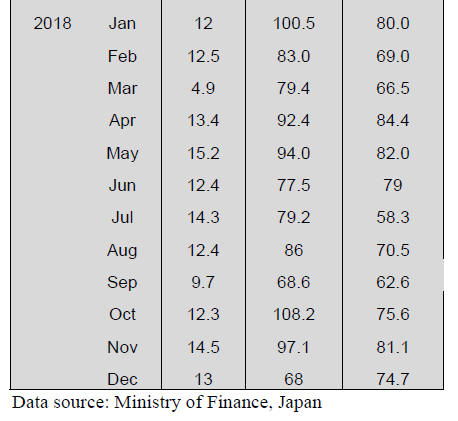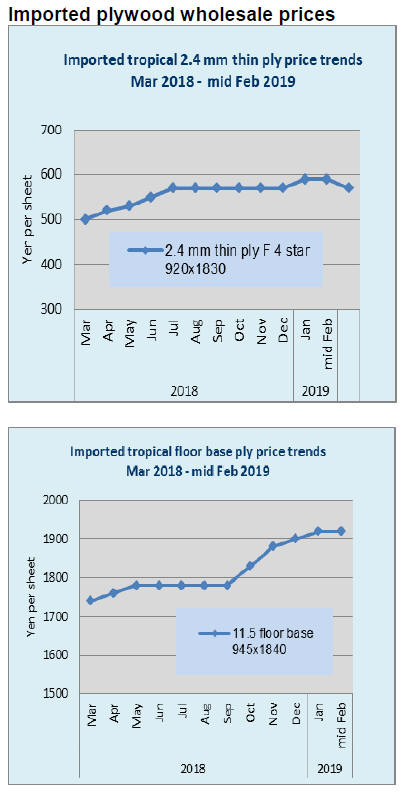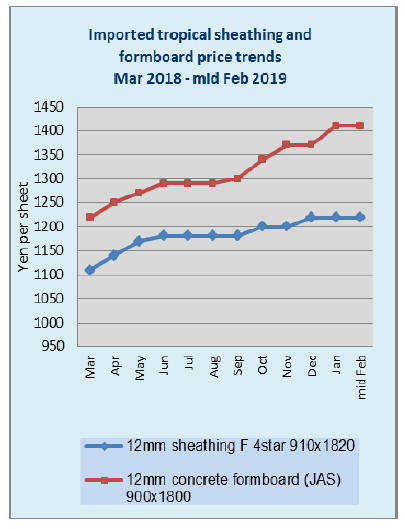Japan
Wood Products Prices
Dollar Exchange Rates of 10th
February
2019
Japan Yen 110.47
Reports From Japan
¡¡
Annual wage negotiations focus on
small company
issues
Japan's largest labour and business organizations, Rengo
and Keidanren (the Japan Business Federation) have
agreed in advance of the annual wage negotiations that
workers pay should be raised but have yet to decide on
what basis discussion on raises should be.
However, both agreed that workers income has a direct
bearing on the economy as consumer spending looms
large in the direction of economic growth.
The point made in advance of the wage negotiations by the
leader of Rengo was that most Japanese are employed by
small and medium sized companies who complain they
have not seen any improvement in sales and profit over the
past year.
Continuing saga of inaccurate economic data
In another twist in the saga of Japan¡¯s misrepresented
statistics it has been revealed that there is a serious
divergence between official GDP data and an alternative
series calculated by the Bank of Japan. This follows on
from the revelation that wage growth data was incorrectly
collected.
Japanese commentators say the problem is partly because
there is no central statistics bureau in Japan which means
each Japanese government ministry has its own statistical
department and decides how the data will be collected and
compiled.
Rise in domestic consumption compensates for drop
in exports
Japan's gross domestic product grew in the third quarter
2018 reversing the sharp decline in the previous quarter.
The positive numbers were mainly the result of a rise in
domestic consumption and business investment which
combined to offset weak exports.
Seasonally adjusted GDP rose at an annualised 1.4% in the
fourth quarter according to data released by Japan¡¯s
Cabinet Office.

Beginning of US/China trade talks boosted US
dollar
In early February the US dollar strengthened against the
yen on the news that initial talks between Chinese and US
officials on the trade dispute have started. However, the
rise was quickly eaten away after weaker than expected
data on US retail sales was released.
US retail in January dipped below levels seen in 2009 a
clear signal that consumer spending, which accounts for
around two-thirds of the US economy, is weakening.

Second consecutive yearly decline in housing
starts
2018 housing starts fell just over 2% year on year marking
the second consecutive decline. Homes in the ¡®for rent¡¯
sector saw a 5.5% drop, the first in 7 months and there was
a slight drop in custom-built homes and other owner
occupied housing. Regionally, starts for housing for sale
rose in both Osaka and Aichi Prefectures but dropped
almost 15% in Tokyo.
Analysts continue to point out there are no signs of
housing starts sky-rocketing in advance of the planned
October consumption tax rise.

Doors
2018 wooden door imports
Japan¡¯s 2018 imports of wooden doors (HS 441820) are
shown below. Year on year there was little change in the
value of wooden door imports. China was the major
supplier accounting for around 60% of all wooden door
imports. Other suppliers included the Philippines 20%,
Indonesia 7%, Malaysia 6% and Sweden 2%. These top 5
suppliers accounted for over 90% of 2018 wooden door
shipments to Japan.

Windows
2018 wooden window imports
In contrast to the imports of doors, 2018 wooden window
imports into Japan rose 8% from a year earlier. As in
previous years there was a noticeable rise in second half
year imports with the first quarter of the year being much
quieter.
The top 5 shippers of wooden windows (HS 441810) in
2018 were China 35%, USA 27%, the Philippines 22%
Sweden almost 9% and Italy.

2018 assembled wooden flooring imports
The value of Japan¡¯s 2018 imports of assembled wooden
flooring (HS 441871-79) was unchanged from a year
earlier. As was normal imports dipped early in the year
mainly because of the impact of winter weather on
construction activity.
Wooden flooring in HS441875 accounted for around 80%
of all assembled wooden flooring imports with China,
Thailand and Indonesia providing most of the supply.
HS441879 accounted for 18% of 2018 imports of
assembled wooden flooring being shipped from China
(57%), Indonesia (14%) and Malaysia (9%). The value of
Japan¡¯s imports of HS 441873 and HS441874 is small.

2018 plywood imports
Three supply countries account for over 85% of Japan¡¯s
imports of plywood, Malaysia, Indonesia and China. In
recent years shipments from Vietnam have been
increasing.
In 2018 shipments of plywood (HS 441210-39) accounted
for 45% of all plywood arrivals followed by Indonesia
(39%) and China 6.5%).
There are major changes being seen in Japan¡¯s production
and imports of plywood as supplies from manufacturers in
Sarawak have been forced to reduce production due to
stricter log harvesting regulations.
It is unlikely that any shortfall from Malaysia can be made
up quickly by either Indonesia or Vietnam which is putting
pressure on Japanese plywood makers to source logs from
domestic forest resources, a move that is being actively
encouraged by the government.
 
¡®Clean Wood¡¯ seminar to report on ITTO study
The Japanese Forestry Agency is developing a website to
provide information to the timber industry on the Japanese
¡®Clean Wood¡¯ Act, laws and regulations.
ITTO has compiled information on five tropical countries
to be included in the ¡®Clean Wood¡¯ website and will
organise a seminar to report on the research undertaken in
the Philippines,Thailand, Brazil, Ecuador and Lao PDR.
Japan¡¯s ¡®Clean Wood¡¯ Act is in support of the promotion
and distribution of legally-harvested wood products.
This Seminar will take place in Tokyo on Friday, 8 March.
For more see:
https://www.itto.int/events/event/id=5925
Trade news from the Japan Lumber Reports (JLR)
The Japan Lumber Reports (JLR), a subscription trade
journal published every two weeks in English, is
generously allowing the ITTO Tropical Timber Market
Report to reproduce news on the Japanese market
precisely as it appears in the JLR.
For the JLR report please see:
http://www.nmokuzai.
com/modules/general/index.php?id=7
Demand projection of imported wood
Five groups of imported wood products such as Japan
lumber Importers Association came up with demand
projection for 2019 by source.
Total of logs and lumber would decline for three straight
years. Lumber would stay the same but imported logs
would decrease. Not only by declining demand for wood
products by dropping new housing starts but also by
withdrawal of wood processing businesses due to high
cost of imported materials.
Log import would be below three million cubic meters,
which is the main factor of dropping imported wood
demand.
Forecast of new housing starts in 2019 is 920,000-930,000
units, slight decline from 2018 so there would not be any
sizable decline of total wood demand.
Consumption tax will be raised from 8% to 10% in
October 2019 but last minutes rush demand surge before
rate increase is not expected.
Forecast of log import is 2,981,000 cbms, about 260,000
cbms less than 2018. The largest decrease of North
American logs by 220,000 cbms to 2,350,000 cbms is the
main factor of decline of log import. The reason is
withdrawal of Toa Ringyo, which is the second largest
Douglas fir lumber manufacturer.
Other Douglas fir lumber manufacturers would try to
cover up shortfall of Toa¡¯s supply volume but 100%
coverage is impossible.
Supply of South sea hardwood logs would continue
declining because of export ban in Sabah and decreasing
supply from Sarawak.
Russian log import would further decline by increase of
log export duty by the Russian government.
New Zealand log cost would continue climbing by
massive purchase by China and sawmills in Japan are
shifting to use domestic species.
Lumber import from North America, South Sea and
Russia would decrease some but from Europe, New
Zealand and Chile would increase so total would be the
same as 2018 with 6,220,000 cbms.
Lumber prices from North America in 2018 climbed
sharply in the first half then dropped in the second half but
basic demand is unchanged in Japan. Cost of European
lumber would continue high particularly of lamina so the
manufacturers in Japan have been struggling.
Demand for North American and European lumber has
been shifting to domestic wood.
Plywood
Movement of plywood is steady. Orders for domestic
softwood plywood by precutting plants are busy. Some
items of imported plywood are getting tight since future
purchase is inactive because of gap between suppliers¡¯
prices and market prices in Japan. Tight supply would
continue in this situation and dealers, which carry
inventories are marketing cautiously.
Production of domestic plywood in November was
272,600 cbms, 3.6% less than November last year and
1.0% less than October. In this, softwood plywood was
260,500 cbms, 4.0% less and 1.1% less.
The shipment of domestic plywood was 295,900 cbms,
4.9% more and 0.7% more, out of which softwood was
283,100 cbms, 5.4% more and 1.2% more. This is the
record high monthly shipment and first time that the
volumeexceeded 280,000 cbms. Shipment of both
structural and non-structural was active.
The inventories are 140,600 cbms, 22,500 cbms less than
a month ago. Orders in December was active from both
direct route like precutting plants and wholesale channels
and some plywood manufacturers sold out January
production.
As future offer prices of imported plywood continue
climbing by the suppliers, market in Japan show some
signs of tightening. In the second half of last year,
importers reduced purchase volume by climbing export
prices and dull demand in Japan so future arrivals would
continue low.
Inventory of green concrete forming panel and structural
panel is low without any hope of recovery.
 
South Sea (Tropical) logs and lumber
South Sea hardwood log prices continue climbing after
Malaysia raised minimum wages since January 1,
2019 and Sarawak government increased timber harvest
tax.
Present meranti regular log prices in Sarawak soared to
nearly US$320 per cbm FOB, which
h is almost unacceptable level for users in Japan.
However, log market prices in Japan are holding steady.
Supply source of South Sea logs for Japan has shifted to
PNG and PNG log prices are lower than Sarawak as a
result of slowdown of Chinese log purchase by economic
recession of Chinese economy. Trend of yen¡¯s
appreciation since early this year helps reduce log cost.
Demand for South Sea lumber including lumber from
China continues depressed so that the inventories have not
dropped.
Prices of mercusii pine free board are weak so that the
dealers are not able to place new orders to the suppliers.
Movement of poplar LVL and falcate laminated free board
for DIY stores is firm.
Russia increases log export duty
Export duty on three species (larch, spruce and fir) in Far
East Russia is raised by 15 points to 40% since January
2019.
This will be increased to 80% in 2021, which practically
stops log export. However, if more than 25% of export
sales amount by log exporting companies is processed
products such as lumber, veneer and wood chip for last
three years, log export duty is held at 6.5% for 2019 for
such companies.
Purpose of higher log export duty is to promote
industrialization of Far East forest industry but there are
only limited companies, which already have wood
processing facilities so log export will be more difficult.
For Russian log users in Japan such as lumber and
plywood mills, increasing log export duty means higher
log cost so they have been switching to domestic species
and end users of lumber are buying Russian made lumber
or genban for reprocessing.
Malaysia increases minimum wage
The Malaysian government increases the minimum wage
to 1,050 Ringgit since January 1, 2019. Minimum wage
was set differently in peninsula Malaysia and Sabah and
Sarawak in Borneo before but the government decided to
make one uniform rate in all Malaysia since this year.
The new wage rate is 1,050 Rgt and this is 14.1% increase
in Sabah and Sarawak.It was 1,000 Rgt in Peninsula
Malaysia and 920 Rgt in Sabah and Sarawak.
New Mahatir regime plans to increase the minimum wage
to 1,500 Rgt in five years so the rate will continue to
climb. Furthermore, Sarawak government increases timber
harvest tax. Present rate is 0.6 Rgt (0.14 dollar), which is
raised to 5 Rgt ($1.2) since January 1, 2019. This is to
promote replantation and industrialization of forest
industry in Sarawak.
By increased minimum wage and timber harvest tax,
production cost of plywood would climb by $15 per cbm.
Plywood manufacturers in Sarawak need to increase
export prices by cost push so further price hike is
inevitable.
Present prices are $580-590 per cbm on 3x6 JAS uncoated
concrete forming panel and $680-690 on concrete forming
panel for coating.
|